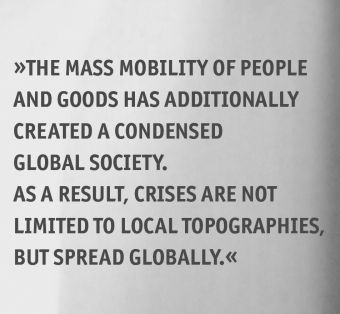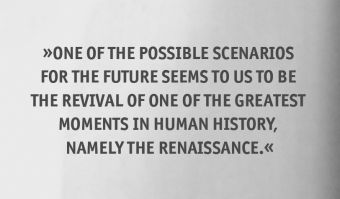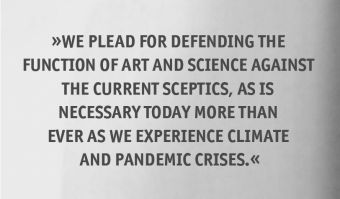
Renaissance 3.0
Artistic-scientific Director and CEO of ZKM Center for Art and Media, Karlsruhe and Director of Peter Weibel Research Institute for Digital Cultures at University of Applied Arts, Vienna

Renaissance 3.0
A scenario for art in the 21st century
The turn of the 21st century has been marked by a series of crises on a global scale. Through the infosphere, that electromagnetic envelope that surrounds Planet Earth and which we have been using for communication since the mid-19th century through radio technology, from telephones to satellites, a global society emerged in the course of the 20th century. News that used to take months from source to receiver—of earthquakes to stock market fluctuations—is now distributed almost simultaneously across the globe. The mass mobility of people and goods has additionally created a condensed global society. As a result, crises are not limited to local topographies, but spread globally. From the climate crisis to the migration crisis, from the financial crisis to the COVID-19 crisis, we are witnessing ever more profoundly shattering consequences. Principles of our civilisation built on the successes of humanism and the Enlightenment—for example, the universalism of human rights, equality of race, gender and age before the law, autonomy of the individual, freedom of the press and arts, democracy—are increasingly being challenged. Due to the climate crisis, the overall habitability of Planet Earth by humans—and thus humanity’s ability to survive—is being called into doubt. Mass migrations in the coming decades could therefore radically change the face of the Earth and the social systems that have
Picture above: Peter Weibel, Copyright: ZKM | Zentrum für Kunst und Medien Karlsruhe, photo by Christof Hierholzer
prevailed up to now. Therefore, it is necessary to propose a navigation system that prevents the failure of the mission of humanity on the good ship Earth. One of the possible scenarios for the future seems to us to be the revival of one of the greatest moments in human history, namely the Renaissance.
Most people think of the Italian Renaissance (15th, 16th and early 17th centuries) when they hear the term Renaissance, which stands for an era that surpassed anything that had gone before in terms of freedom, progress and discovery. However, it is important to note that there was an Arab Renaissance before the Italian Renaissance, from 800 to 1200, which has only come into focus in recent years.1

Italian Renaissance
The Italian Renaissance stands for a cultural revolution that ushered in a new attitude to the world and to humanity that was decisive in the history of the Western world. For many people, the Renaissance is regarded as a time of new beginnings, in which art and science flourished as never before and as never since. An example of this could be the painting La scuola di Atene (The School of Athens) by the painter Raphael, which he realised in the Stanza della Segnatura of the Vatican from 1510 to 1511. The title of this painting illustrates a central important aspect of the Renaissance, namely the rebirth of antiquity. Similarly, the rediscovery of Lucretius‘ ancient text De rerum naturae (On the Nature of Things) influenced artists like Botticelli, but also scientists like Bruno Giordano and Galileo Galilei. The last existing copy was discovered in a German monastery in 1417. Erwin Panofsky pointed out in his seminal work Idea: A Concept in Art Theory (1924) that the terms idea and type originated in the philosophical vocabulary of the Greeks, from which developed the cult of the ideal that prevailed in Europe until the days of Romanticism. That is why German masters such as Albrecht Dürer, and the three Nuremberg masters who worked with perspective representation——Lorenz Stöer, Wenzel Jamnitzer and Johannes Lencker—should also be considered.Decisive for the Renaissance, however, is Leonardo da Vinci’s quote, „Se la pittura è ’scienza o no,” with which he opens his famous manuscript Trattato della pittura (written circa 1490, published 1651). The claim was quite clear: „Painting is a science.” Renaissance, then, is the scientification of art. That is a central aspect of the Renaissance.
Up until the Renaissance, artists were considered craftsmen, belonging to artes mecanicae. In the Renaissance, they increasingly saw themselves as representatives of the artes liberales, i.e. as scientists and scholars. Renaissance artists repeatedly portrayed themselves as scholars, for example by featuring compasses, mirrors and small globes in their self-portraits as well as depicting their tools of the trade: canvases, brushes, perspective devices, and so on. Federico Zuccaro staged himself in his self-portrait as a reader of a book. These artists were concerned with optics and rays of vision and the theory of proportions. Piero della Francesca was, as it were, a calendar mathematician. He was interested in the doctrine of polyhedra.
A second central aspect of the Renaissance was the discovery of the individual. Whether in art, science, economics or politics, it was individuals who devoted themselves to exploring new horizons, new spaces at their own risk, be it the exploration of the seas by Columbus and Magellan or of celestial bodies by Galileo. The artist, the navigator, the explorer discovered new worlds, often against prevailing ideologies and doctrines. The Renaissance was thus the epoch of the triumph of individuality and this triumphant march has continued to this day. From the architecture of a Palladio to Titian, from Leonardo da Vinci to Giulio Romano, from Benvenuto Cellini to Michelangelo, we observe the the discovery of the individual.
Art as science and the expression of the individual’s abilities are thus the two most important aspects of the Renaissance for the future of art.

Arab Renaissance
But the Italian Renaissance was not the first scientification of art. The Arabic Islamic Renaissance occurred between 800 and 1200. The Banū Mūsā brothers created programmable musical automata around 850. Ibn al-Razzuz Al-Jazari wrote the book Compendium on the Theory and Practice of the Mechanical Arts around 1200. From Baghdad to Andalusia, Arab artists and scholars, such as Ibn Khalaf al-Murādī and Abū Ḥātim al-Muẓaffar al-Isfazārī, rediscovered and advanced Greek and Byzantine traditions. For example, the term algorithm comes from a Latinisation of the name of the Arab scholar Abu Jafar Muhammad ibn Musa al-Chwārizmī. As Hans Belting has documented in Florence and Baghdad, Abū ‚Alī Ibn al-Haiṯam (965-1040, known in the West as Alhazen) wrote Kitāb al-Manāẓir. His work was translated into Latin in the 12th century and contains fundamental studies on the propagation and refraction of light. The reception of Ibn al-Haiṯam’s theory of light and vision triggered one of the most exciting chapters in the history of Western art. Alhazen can be considered the inventor of the camera obscura and the forerunner of the invention of perspective. Perspectiva was the Latin title of his Arabic work on optics which was later replaced by the Greek term Optics and then again by the Latin Opticae Thesaurus (1572).
Renaissance 3.0
In this respect, the Arab Renaissance was the first, the Italian the second, and now in the 21st century there are convincing signs that we are experiencing a third Renaissance. In contrast to the two, relatively localised Arab and Italian Renaissances, the latest manifestation is global. Artists from China to Chile form a new generation of art-based research and research-based art. New works of art and scientific theories are emerging that do not only refer to the historical achievements of the preceding renaissances. Clearly, there are continuations of lines of tradition. For example, façade decorations by Falconetto in Verona foreshadow projection mapping on public buildings. Likewise, Paolo Veronese’s frescoes can be seen as precursors to immersive environments. In the future, new scientific disciplines, especially expanded forms of the life sciences, will determine our lives. The new society will therefore not only be about automata and robots; there will also be a shift from the mechanical and machine-based renaissances: that is, from hardware, to the new renaissance of software, programming, codes.

In this respect, genetics, molecular biology, all forms of the new life sciences, artificial intelligence, quantum optics, climate research, health care, the infosphere, the data society, questions of cyborg feminism (see Donna Haraway and Joanna Zylinska) will be central.
In the 21st century, there is a new basis for the convergence of the arts and sciences. Artists and scientists share a common „pool of tools“. Tools that dentists use, for example, small cameras that illuminate the oral cavity, are also used by artists. The same computers and screens are used by artists and scientists, as are algorithms and data networks. Mathematical equations slide over into genetic entities, both for physicists and artists, and geometric entities and fluid objects transform into data, into data curves, both in science and in art.
As long as art remained within the horizon of visible things that our natural organ, the eye, captures, it was difficult to build a bridge to science which, since the 17th century, has captured the world with instruments and apparatus, from telescopes to microscopes. With such apparatus, science opened the door to the previously inaccessible res invisibiles. As long as art refused to use such apparatus, it was fundamentally different from science. Art ended at the limits of natural perception. Science begins where natural perception ends, that is, beyond natural perception. With the rise of media since photography (circa 1840), media art also uses apparatuses and algorithms like science. This is the new basis of the convergence of science and art for a new renaissance.
The art of the 21st century will be dominated by this Renaissance 3.0 and will thus face the many challenges of humanity. One of these challenges is that the function of art and science to give meaning to the rerum naturae (Lucretius)—to the things of the world and nature, and to human beings—is being reinstated at this historical moment even as the function of science is being doubted. Hegel famously claimed that after religion and art, it is philosophy that recognises the absolute, that is, that gives us meaning and knowledge. We plead for defending the function of art and science against the current sceptics, as is necessary today more than ever as we experience climate and pandemic crises. The Renaissance 3.0 project will open the general public up to an unprecedented horizon of innovative works of art and, as the Italian Renaissance achieved, a new attitude towards the world and the future of symbiotic life of all living beings on Planet Earth.
References
1 Siegfried Zielinski, Peter Weibel, Allah’s Automata. Artifacts of the Arab-Islamic Renaissance (800-1200). Ostfildern: Hatje Cantz 2015
Peter Weibel
Peter Weibel is the artistic-scientific director and CEO of the ZKM Center for Art and Media in Karlsruhe and the director of the Peter Weibel Research Institute for Digital Cultures at the University of Applied Arts in Vienna. He is considered a central figure of European media art on account of his various activities as an artist, theoretician, and curator. He publishes widely on the intersecting fields of art and science. His career took him from studying literature, medicine, logic, philosophy, and film in Paris and Vienna to working as an artist and lecturer and then to heading the digital arts laboratory at the Media Department of New York University in Buffalo from 1984 to 1989. He later became the founding director of the Institute of New Media at the Städelschule in Frankfurt from 1989 to 1994 and professor of media theory at the University of Applied Arts in Vienna from 1984 to 2011. He was the artistic director of the Ars Electronica festival in Linz from 1986 to 1995, the Seville Biennial (BIACS3) in 2008, and the Moscow Biennale of Contemporary Art in 2011. He commissioned the Austrian pavilions for the Venice Biennale from 1993 to 1999 and was the chief curator of the Neue Galerie in Graz from 1993 to 2011. Picture © ZKM | Zentrum für Kunst und Medien Karlsruhe, photo by Christof Hierholzer

